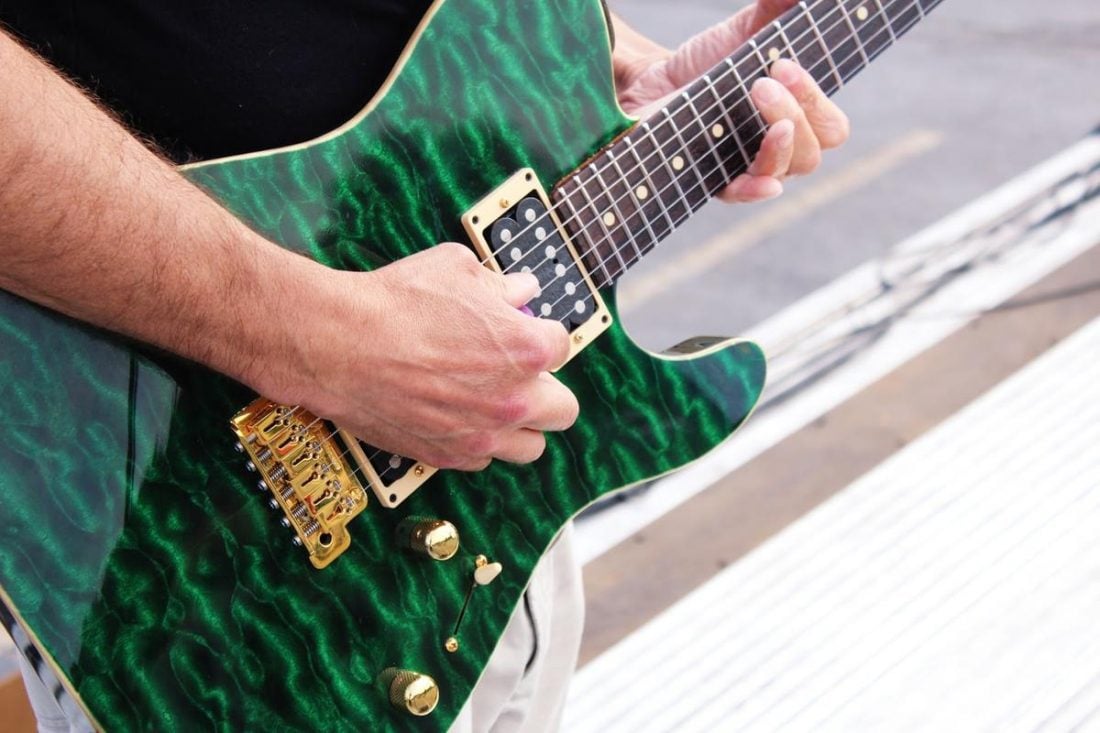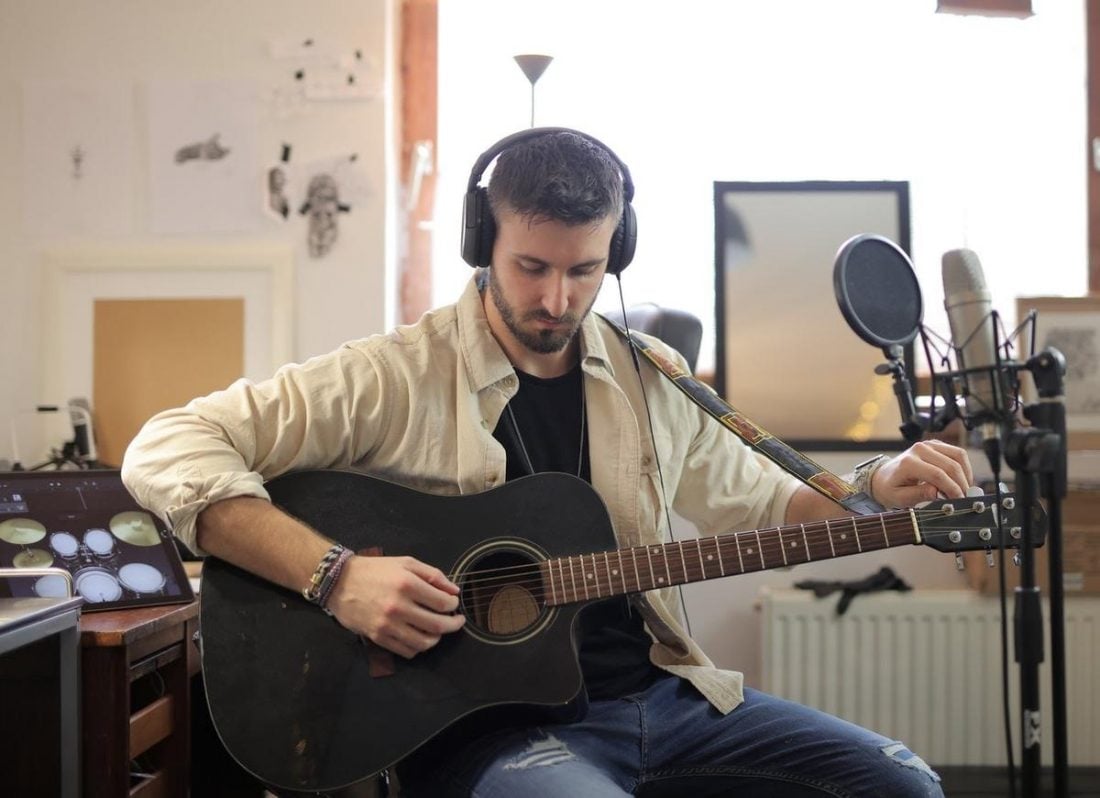Yes, you can play electric guitar with headphones using an amp with a headphone jack or a digital multi-effects processor. This setup allows you to practice silently.
Electric guitar enthusiasts often seek the convenience of playing without disturbing others. Headphones provide a private listening environment, enabling musicians to focus on their technique and sound. Ideal for apartment dwellers or late-night practice sessions, plugging headphones into your guitar setup is a simple solution.
By doing so, you harness the full sonic potential of your electric guitar without external noise interference, allowing for an immersive playing experience. This method is perfect for players looking to practice in quiet environments or refine their skills without any external distractions.

Credit: www.headphonesty.com
Introduction To Electric Guitar And Personal Practice
Embarking on the journey of mastering the electric guitar ignites a rush of excitement and a thirst for creativity. Whether strumming chords for the first time or delving into intricate solos, the path to becoming a proficient guitarist is a personal and often solitary one. Personal practice plays a fundamental role in honing one’s skills, exploring musical ideas, and developing a unique playing style. Embrace the myriad of options available for practicing, including one ultra-convenient method: playing with headphones.
Understanding The Basics Of Electric Guitars
Electric guitars, a cornerstone of modern music, transform vibrations from their strings into electrical signals. Unlike acoustic guitars, they require an amplifier to project their sound. With a plethora of guitar shapes, sizes, and pickup configurations, understanding these instruments is key to producing the desired tones and expressions. Here are a few fundamental aspects to consider:
- Pickups: Magnetic pickups capture string vibrations and can be single-coil or humbucker, each offering unique tonal characteristics.
- Volume and Tone Controls: These knobs allow players to adjust their sound output and refine their tone.
- Amplifier Connection: Guitars are connected to amplifiers via a 1/4″ instrument cable.
The Advantages Of Playing Guitar With Headphones
Utilizing headphones for electric guitar practice presents multiple benefits. This method amplifies sound directly to the ears, providing a clear and focused auditory experience. Players gain an enhanced perception of their playing nuances and tones, contributing to efficient practice sessions. The advantages include:
- High-Quality Sound: Headphones can deliver consistent sound quality at various volumes.
- Isolation: Isolating the guitar sound helps concentrate on technique and timing.
- Effect Pedals and Modeling: Players can experiment with effects and amp models without disturbing others.
Privacy And Consideration: The Needs For Silent Practice
Practicing within a personal space, devoid of external distractions, is often essential for growth. Headphone use also demonstrates consideration for those nearby, eliminating noise complaints and fostering harmonious relationships. Silent practice is especially vital in the following contexts:
| Late-Night Sessions | Shared Living Spaces | Quiet Environments |
|---|---|---|
| Allows for practice without disturbing the peace after hours. | Respects the space and comfort of housemates or family members. | Enables practice in noise-sensitive areas like apartments or hotels. |

Credit: m.youtube.com
Technical Aspects Of Using Headphones With Electric Guitars
The Technical Aspects of Using Headphones with Electric Guitars can seem daunting at first, but with the right knowledge and equipment, practicing guitar in silence becomes a straightforward task. Whether you’re in an apartment, on the road, or simply don’t want to disturb others, this section will guide you through everything you need to know to connect your electric guitar to headphones.
Overview Of Necessary Equipment And Connections
To begin playing your electric guitar through headphones, understanding the necessary equipment and connections is key. Here’s a quick overview:
- Electric Guitar: Your primary instrument.
- Headphones: A set of quality headphones to transmit sound.
- Amplifier/Modeling Amp: To process the guitar signal before it reaches your ears.
- Audio Interface/Guitar-to-USB Cable: For connecting your guitar to a computer or mobile device, if you’re not using an amp.
- Adapter: Depending on your headphones, you may need a 1/4″ adapter to connect to an amp or interface.
Types Of Headphones Suitable For Electric Guitar Practice
Not all headphones are created equal when it comes to practicing electric guitar. You’ll want to look for headphones that:
- Offer a wide frequency range to accurately reproduce your guitar’s tones.
- Have a low impedance, making them easier to drive with various audio devices.
- Provide good noise isolation to minimize distractions.
- Feature comfort for extended practice sessions.
Typically, closed-back and over-ear headphones are preferred by guitarists for their sound isolation and audio quality.
The Role Of Amplifiers And Modeling Amps In Silent Practice
Amplifiers and modeling amps play a crucial role in silent practice. They not only enhance the signal from your guitar but also offer a plethora of sound options. Many modern amplifiers and modeling amps come with built-in headphone jacks, granting you instant access to silent practice. Some models provide various amp simulations and effects, adding versatility to your practice sessions without any noise complaints.
Use Of Audio Interfaces And Guitar-to-usb Cables
Apart from traditional amplifiers, audio interfaces and guitar-to-USB cables are invaluable tools for silent practice. They allow you to connect your electric guitar directly to a computer, where you can use software amplifiers and effects. This method is excellent for recording and gives you a massive range of sounds to explore with your headphones. Remember to install any necessary drivers and ensure your audio interface is compatible with your computer’s operating system.
Enhancing The Experience Of Playing With Headphones
Imagine immersing yourself in a sonic oasis, where every strum resonates with pristine clarity and your electric guitar’s vibrancy is matched only by the privacy of your experience. Playing electric guitar with headphones isn’t just about keeping the noise down—it’s a doorway to a world of focused practice and personal exploration. Let’s amplify this auditory adventure and explore how you can shape a high fidelity musical journey with your headphones.
Achieving High-quality Sound And Tone With Headphones
Sound quality is paramount when playing guitar through headphones. The right pair can reveal nuances and details in your playing that might otherwise go unnoticed. To ensure you’re getting the best out of your sessions:
- Choose headphones with a wide frequency range to capture the full spectrum of your guitar’s tone.
- Opt for closed-back headphones for better sound isolation and a more intimate playing environment.
- Consider models with a flat response for an accurate and uncolored representation of your guitar’s sound.
Adjusting Guitar And Amplifier Settings For Headphone Use
To tailor the output specifically for headphones, adjustments to your guitar and amp settings might be necessary. Some amplifiers come with a dedicated headphone output that automatically applies an appropriate EQ profile. If your amp lacks this feature:
- Reduce the bass frequencies to prevent muddiness.
- Adjust the mid and treble settings to retain clarity and definition.
- Experiment with the presence or contour controls to find a pleasing headphone mix.
Effects And Pedals Compatibility With Headphone Sessions
Enhancing your tone with effects and pedals can be just as satisfying through headphones. To ensure compatibility:
- Verify that your pedals can handle headphone-level output.
- Use a multi-effects processor with a headphone out for a streamlined setup.
- Patch-in virtual effects if your amp or interface offers that feature for added versatility.
Tips For Avoiding Ear Fatigue During Extended Headphone Sessions
Extended playtime with headphones can lead to ear fatigue. Combat this by:
- Taking regular breaks to give your ears a rest.
- Keeping the volume at a comfortable level—louder isn’t always better.
- Switching between different pairs of headphones to change the pressure points around your ears.
- Using headphones with a comfortable, ergonomic design.
Alternatives And Precautions For Headphone Use
Electric guitarists often seek the thrill of playing through a blasting amplifier, but there are times when you might want to jam without disturbing others. Fortunately, playing electric guitar with headphones can be a seamless and enjoyable experience if you consider some alternatives and take certain precautions. From wireless headphones that offer freedom of movement to pocket amplifiers that preserve tonal quality, many solutions exist for practicing in silence. It’s important to address the challenges and consider the safety of your hearing, so let’s delve into the options available to guitarists looking to rock out quietly.
Wireless Headphones And Latency Issues
Using wireless headphones while playing guitar can be liberating, allowing for movement without cable restrictions. But one critical factor to consider is latency, which refers to the delay between playing a note and hearing it through the headphones. This delay can hamper your playing experience.
- Choose headphones with low latency to minimize delay.
- Check for headphones designed specifically for musicians.
- Invest in headphones that use aptX Low Latency codec if using Bluetooth.
Safety Concerns And Hearing Protection
When plugging into your electric guitar with headphones, your ears are in a closed environment. This setup requires careful volume management to avoid hearing damage.
Precautions for safe headphone use include:
- Avoid high volume settings that can lead to hearing loss over time.
- Take regular breaks to give your ears a rest.
- Consider using headphones that provide good isolation to prevent the need for excessive volume.
Portable Solutions: Pocket Amplifiers And Multi-effects Processors
For those who desire a portable and straightforward setup, pocket amplifiers and multi-effects processors offer great tone and flexibility without a full-sized amp. These devices are small enough to fit in your pocket but packed with features to simulate various amp sounds and effects.
| Device Type | Benefits |
|---|---|
| Pocket Amplifiers | User-friendly, simple setup, decent sound quality |
| Multi-effects Processors | Versatile effects, amp simulators, often include tuners and metronomes |
Ensure you choose a device with a headphone jack and reliable sound output to match your practice needs.
Exploring Apps And Software For Silent Practice
Finally, technology brings the guitar experience to your fingertips with apps and software designed for silent practice. These tools transform your device into a virtual amplifier with a host of effects.
- Look for apps with a ‘silent practice’ feature.
- Try out different software to find the one that suits your style.
- Some software options may require additional hardware, such as an audio interface.
By using the right application, you can play your electric guitar with minimal setup and still enjoy a full range of sound.

Credit: www.headphonesty.com
Can You Play Electric Guitar With Long Nails While Using Headphones?
Playing electric guitar with long nails electric guitar can be a challenge for some musicians. The length of the nails may hinder finger placement and string control, potentially affecting performance. However, with practice and proper technique, it’s possible to adapt and create beautiful sounds without sacrificing personal style or comfort.
Frequently Asked Questions On Can You Play Electric Guitar With Headphones
Can Electric Guitar Be Played Through Headphones?
Yes, electric guitars can be played through headphones using a headphone amp or a multi-effects processor with a headphone output.
Can You Play Electric Guitar Silently?
Yes, you can play an electric guitar silently by using headphones with an amp or a multi-effects processor with a headphone output. Silent practice is also possible with a silent guitar or through software-based amp simulators.
How Loud Is Electric Guitar With Headphones?
An electric guitar with headphones can be quiet to the outside world, offering a personal listening volume that is easily controlled by the user.
How Do I Connect My Headset To My Electric Guitar?
To connect a headset to an electric guitar, use a headphone amplifier that plugs into your guitar’s output. Then, attach your headset to the amplifier’s headphone jack.
Conclusion
Absolutely, rocking out on an electric guitar with headphones is achievable and practical. It allows practice without disturbing others, ensuring that your musical journey needn’t be silenced. Investing in a quality amp and headphones is essential for the best sound clarity and experience.
Happy strumming in your personal, soundproof haven!
